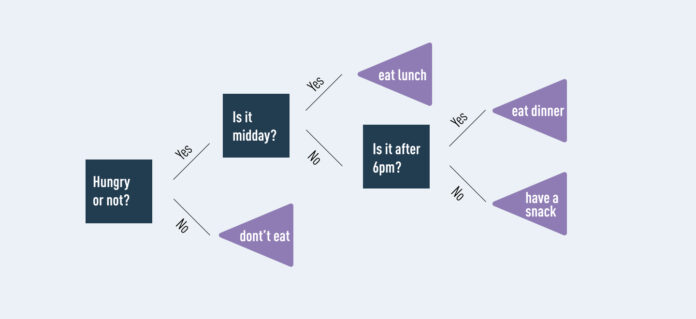A Decision tree Template It can be difficult to choose the right action plan for companies .
A decision tree is a diagrammatic representation of the possibilities for each scenario before making a decision. Because the model often looks like a tree with branches, the term “decision tree” was invented.
Decision trees can be used to explain decision-making in uncertain situations. They can be used to start a conversation, or provide an algorithm that will determine the best way to proceed. It visualizes a ‘if that, then that’ expression for all possible solutions.
Because it allows planners and analysts to assess the impact of significant changes across multiple business domains, a decision tree is an essential component of long term strategic planning. It can be used by organizations to compare different alternatives’ costs, opportunities, and rewards.
It is useful for analysing numerical data and making decisions based on numbers. It can be used in many areas, such as administration, budgeting and project planning.
What is a Decision Tree Template?
Every business must take into account many factors before making a decision. A decision tree is a tool that can help businesses make difficult decisions quickly and efficiently.
The decision tree can be used to evaluate the decision-making process and its outcomes before making a decision.
Teams that use the Decision Tree Template (also known as a Decision Tree Diagram) can communicate potential outcomes and options better before making a decision.
A decision tree begins with a significant issue. It links words and checkboxes to the two options and the outcome you choose. The shape of the tree shows what would happen if the decision making process was followed.
A decision tree typically has one node at its beginning, which branches out to possible outcomes. There are three types of these nodes: probability nodes (end nodes), choice nodes (choice nodes) and option nodes (probability nodes).
A probability node based on a circle shows the likelihood of different outcomes. A choice node (shown by a square) indicates an action to take, while an end node shows the outcome of a decision pathway.
Why is a Decision Tree important in business?
The decision-tree template is a useful tool that most companies use. Decision trees can be extremely beneficial for young entrepreneurs and small businesses, as they often have less resources and are more difficult to obtain funding.
To understand and analyze the project situation, you can create a decision tree with your team. You can also use decision trees to explore different scenarios and visualize the outcomes without spending money.
Decision trees can also be used by larger commercial firms to evaluate solutions before they are delivered to a wider audience or to a client who is more demanding.
A decision tree is a tool that can automatically create predictive analytics. This is useful in data collection and machine learning.
Decision trees can be used to assess potential financing, determine whether there is a new market opportunity, and examine the commercial viability of a product.
How Decision Trees Can Help With Business Decisions
The decision tree is an effective decision making tool because it assists executives in understanding the options, risks, rewards, data requirements, and other factors involved in an investment dilemma.
The decision-tree method helps you to address the problem in a logical and ordered manner. This will lead to a satisfactory answer.
The method can be applied to business decisions and creates a document record of all inputs, how you reviewed them, and the reasons for your final decision.
These are just a few ways that a decision tree can be used to help business leaders make difficult decisions for their companies.
Possibilities
The first step in a decision tree is to evaluate all the options. It helps you decide which options will achieve your desired effect.
Start by drawing a square on one side of a piece of paper. These lines will show you the root activity. Two horizontal lines running to the court’s right will indicate the different actions.
These options allow you to choose whether to create new CMO services or continue with the one you have.
Events
You are not responsible for the outcome of an event that occurs outside your control. The decision to develop a product or not can have a great outcome.
These alternate occurrences can easily be represented by drawing two or more straight lines that diverge from the end of each line, and then displaying the options to create the item.
A third line, which indicates the lack of product design, is also drawn.
Consequences
The outcome is the result of a decision. It can be measured by the likelihood that specific scenarios will develop after the decision has been made.
Product development is a costly endeavor. You will need to invest money in order to create a product that will increase your overall revenues.
You have a 80% chance of making a profit if you invest. If the project fails, there is a 20% chance that you will receive nothing. There is a 100% chance that you will not generate any additional revenue if it does not succeed.
Final Decision
To make a decision , the decision tree will provide an expected value. The decision tree will tell you whether to proceed or not by entering all relevant information for different situations.
Key Takeaways
Decision trees are useful algorithms that simplify complex decision-making processes. Because it relies on primarily classification and regression methods, it has the best accuracy.
Many professionals in the industry use decision trees to improve their careers or to streamline their business operations.












